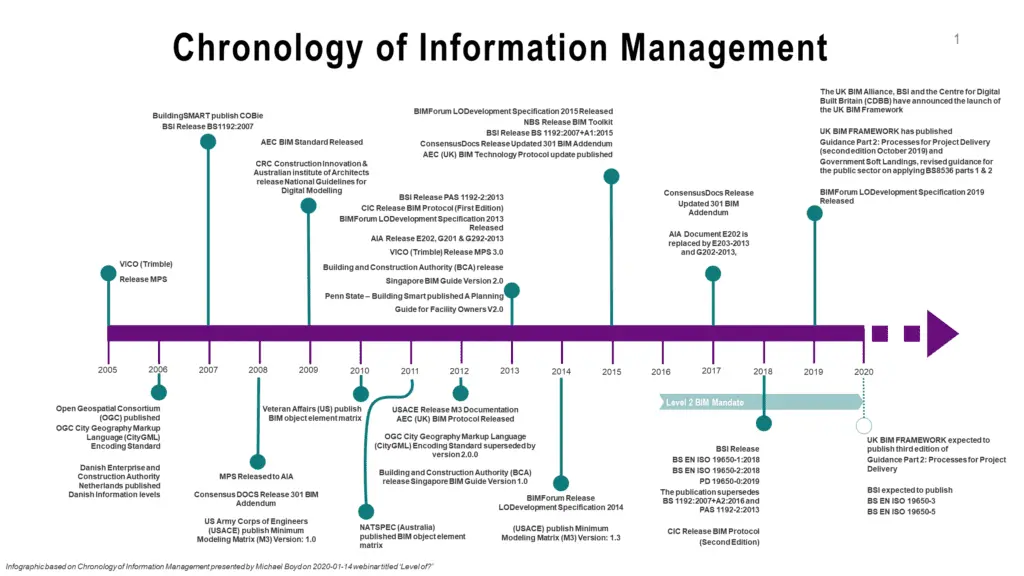quantity
Revit Guides
Data Management
property of a phenomenon, body, or substance, where the property has a magnitude that can be expressed by means of a number and a reference. for example a measure with a unit.
Quantities can appear as base quantities or derived quantities.
EXAMPLE 1 Length, mass, electric current (ISQ base quantities).
[SOURCE: ISO 80000-1:2009, 3.1, modified — Notes 1 to 6 to entry have been removed; EXAMPLEs 1 and 2 and new Note 1 to entry have been added.]
EXAMPLE 2 Plane angle, force, power (derived quantities).
xtdMeasureWithUnit
[source ISO 12006-3 names ]
Table C.1 — BS EN ISO 23386:2020 Base quantities from ISO 80000-1:2009
| Base quantities | Description | Dimension | SI unit | SI symbol |
| Length | One-dimensional extent of an object | L | metre | m |
| Mass | A measure of resistance to acceleration | M | kilogram | kg |
| Time | The duration of an event | T | second | s |
| Electric current | Rate of flow of electrical charge per unit time | I | ampere | A |
| Thermodynamic temperature | Average kinetic energy per degree of freedom of a system | θ | kelvin | K |
| Amount of substance | Number of particles compared to the number of atoms in 0,012 kg of 12C | N | mole | mol |
| Luminous intensity | Wavelength-weighted power of emitted light per unit solid angle | J | candela | cd |
Table C.2 — BS EN ISO 23386:2020 Examples of derived quantities from ISO 80000-1:2009
| Derived quantities | Description | Dimension | SI derived unit | SI symbol |
| Acceleration | Change of the speed or velocity per unit time | LT−2 | metre per sec- ond per second | m s−2 |
| Plane angle | Ratio of circular arc length to radius | 1 | radian | rad |
| Solid angle | Ratio of area on a sphere to its radius squared | 1 | steradian | sr |
| Capacitance | Stored charge per unit electric potential | L−2M−1T4I2 | farad | F |
| Electric field strength | Strength of the electric field | LMT−3I−1 | volt per metre | V m−1 |
| Magnetic field strength | Strength of a magnetic field | L−1I | ampere per metre | A m−1 |
| Electric charge | The force per unit electric field strength | TI | coulomb | C |
| Electrical conduct- ance | Measure for how easily current flows through a material | L−2M−1T3I2 | siemens | S |
| Current density | Electric current per unit cross-section area | L−2I | ampere per square metre | A m−2 |
| Energy | Capacity of a body or system to do work | L2MT−2 | joule | J |
| Entropy | Logarithmic measure of the number of availa- ble states of a system | L2MT−2θ−1 | joule per kelvin | J K−1 |
| Force | Transfer of momentum per unit time | LMT−2 | newton | N |
| Frequency | Number of (periodic) occurrences per unit time | T−1 | hertz | Hz |
| Impedance | Resistance to an alternating current of a given frequency, including effect on phase | L2MT−3I−2 | ohm | Ω |
| Inductance | Magnetic flux generated per unit current through a circuit | L2MT−2I−2 | henry | H |
| Magnetic flux density | Measure for the strength of the magnetic field | MT−2I−1 | tesla | T |
| Volume density | Mass per unit volume | L−3M | kilogram per cubic metre | kg m−3 |
| Permittivity | Measure for how the polarization of a materi- al is affected by the application of an external electric field | L−3M−1T4I2 | farad per metre | F m−1 |
| Electric potential | Energy required to move a unit charge through an electric field from a reference point | L2MT−3I2 | volt | V |
| Pressure | Force per unit area | L−1MT−2 | pascal | Pa |
| Power | Rate of transfer of energy per unit time | L2MT−3 | watt | W |
| Electrical resistance | Electric potential per unit electric current | L2MT−3I−2 | ohm | Ω |
| Electrical resistivity | Bulk property equivalent of electrical resist- ance | L3MT−3I−2 | ohm metre | Ω m |
| Area | Extent of a surface | L2 | square metre | m2 |
| Thermal conductiv- ity | Measure for the ease with a material con- ducts heat | LMT3θ−1 | watt per metre per kelvin | w m−1 k−1 |
| Velocity | Speed and direction of an object | LT−1 | metre per second | m s−1 |
| Angular speed | The angle incremented in a plane by a seg- ment connecting an object and a reference point per unit time | T−1 | radian per second | rad s−1 |
| Volume | Three-dimensional extent of an object | L3 | cubic metre | m3 |

Blog
The Level of and Progression Management systems
The ISO 19650 set of standards introduces a new term:
2020-08-24
1 Comment
smart asset management
The terminology such as digital built environment and smart asset
2022-07-11
No Comments
Quantity Surveyor (QS)
person who provides financial and contractual advice and services for planning, carrying
2022-07-24
No Comments

